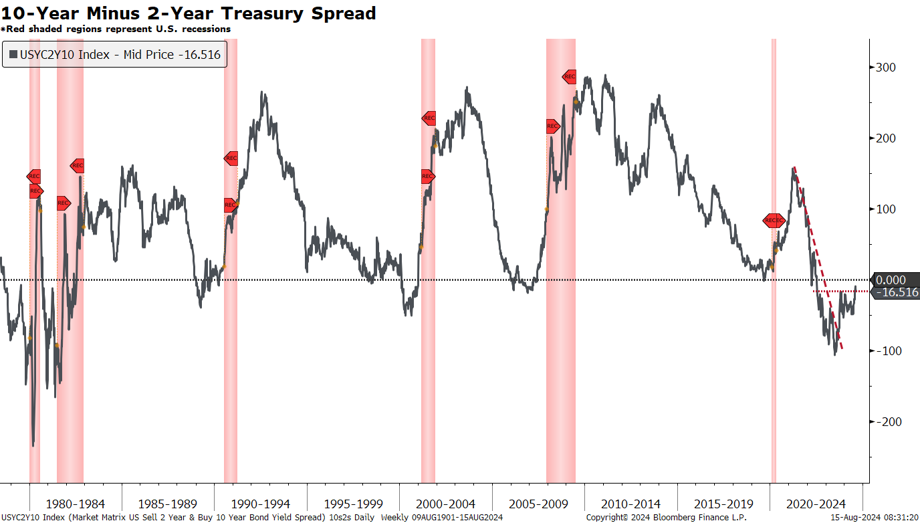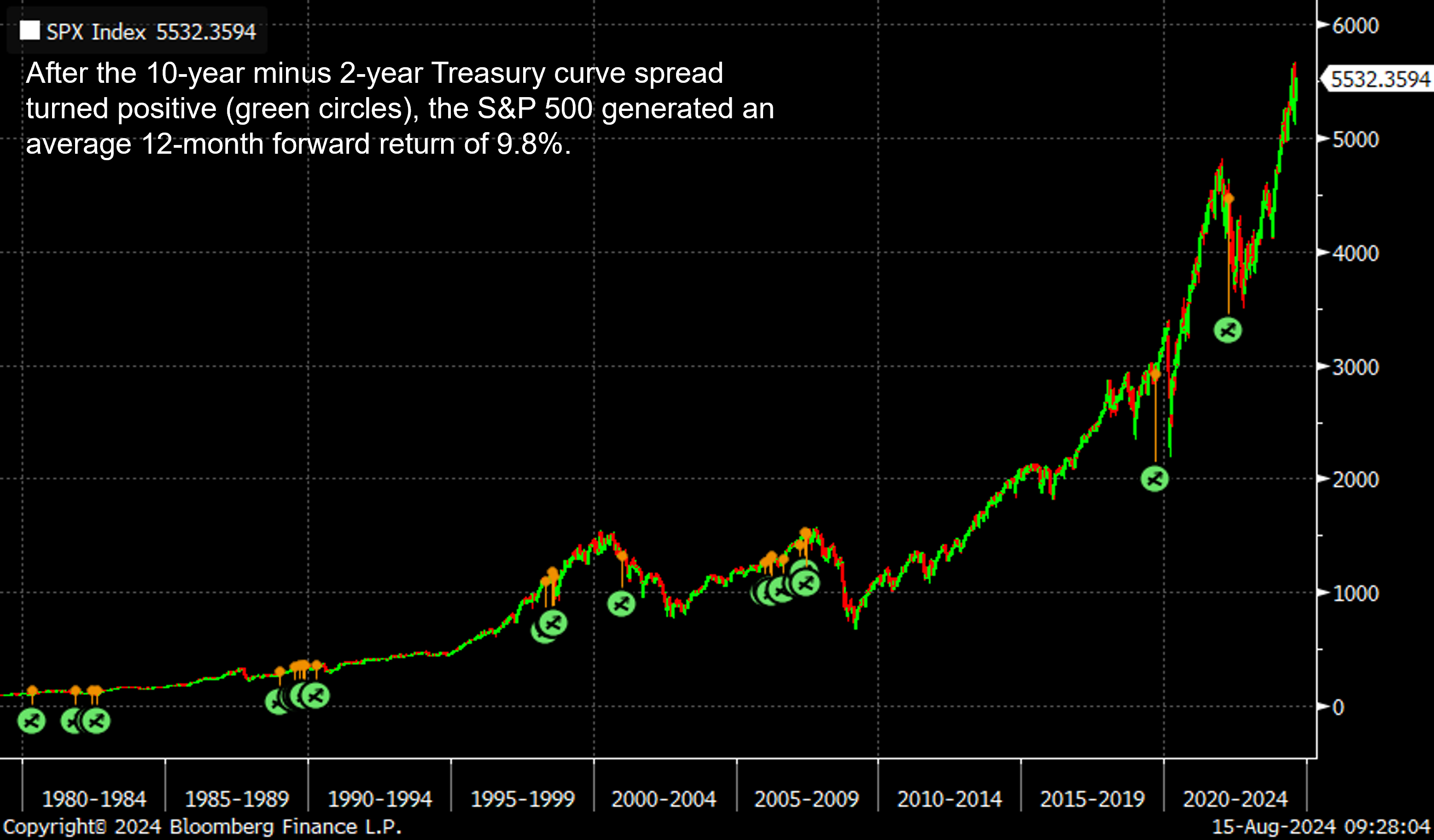Signs of cooling inflation and a slowing but still growing economy have helped drive Treasury yields lower across the curve (today’s move notwithstanding). However, the recent shift on the yield curve has not been parallel across maturities, as the more monetary-policy-sensitive 2-year Treasury yield fell more than 10-year yields.
The bull steepener — when short-term rates fall more than longer-term rates — has left the closely watched 10-year minus 2-year Treasury curve spread only about 0.16% away from ending its record-long inversion of 529 trading days.

Source: LPL Research, Bloomberg 08/15/24
Disclosures: Past performance is no guarantee of future results. All indexes are unmanaged and can’t be invested in directly.
While a dis-inversion of the curve preceded the last four recessions, context is key as Federal Reserve (Fed) rate cuts during those periods had more to do with spurring economic growth than policymaker confidence in receding inflation. The chart below provides some additional background on how the S&P 500 performed one year before and after curve spreads normalized during each of those recessionary periods (2024 is also included for additional context). Despite the negative headlines that often accompany a dis-inversion, only the normalization of the yield curve in 2007 produced a negative forward 12-month return for stocks.
S&P 500 Performance Before and After the Treasury Curve Normalizes
Source: LPL Research, Bloomberg 08/15/24
Disclosures: Past performance is no guarantee of future results. All indexes are unmanaged and can’t be invested in directly.
There is often a lot of choppiness in rates when the 10-year minus 2-year curve spread approaches the breakeven point, and not every crossover above zero results in spreads remaining positive for a prolonged period. Given this backdrop, we also backtested a simple trading model that went long the S&P 500 (a hypothetical buy) every time curve spreads crossed above zero. Of the 23 signals generated on a weekly basis since 1980, the S&P 500 generated an average 52-week price return of 9.8%, with 65% of occurrences producing positive results.
S&P 500 Performance Following All Yield Curve Disinversions
Source: LPL Research, Bloomberg 08/15/24
Disclosures: Past performance is no guarantee of future results. All indexes are unmanaged and can’t be invested in directly.
Summary
The shape of the yield curve receives a lot of attention in the financial media, especially when it crosses above and below zero. However, its use as a recession indicator needs some additional context. First, both an inversion and dis-inversion often precede a recession, but the timing of when the actual recession occurs can vary significantly after each signal. Second, the ominous headlines over the curve normalizing do not necessarily align with historical market performance, as the S&P 500 tends to trade higher after curve spreads cross back above zero.
Overall, LPL’s Strategic and Tactical Asset Allocation Committee (STAAC) maintains its tactical neutral stance on equities, while actively monitoring for signs of an inflection point during this pullback. The Committee maintains its modest overweight to fixed income, funded from cash, which can help buffer against equity market volatility should economic conditions worsen.
***
Important Disclosures:
This material is for general information only and is not intended to provide specific advice or recommendations for any individual. There is no assurance that the views or strategies discussed are suitable for all investors. To determine which investment(s) may be appropriate for you, please consult your financial professional prior to investing.
Investing involves risks including possible loss of principal. No investment strategy or risk management technique can guarantee return or eliminate risk.
Indexes are unmanaged and cannot be invested into directly. Index performance is not indicative of the performance of any investment and does not reflect fees, expenses, or sales charges. All performance referenced is historical and is no guarantee of future results.
This material was prepared by LPL Financial, LLC. All information is believed to be from reliable sources; however LPL Financial makes no representation as to its completeness or accuracy.
Unless otherwise stated LPL Financial and the third party persons and firms mentioned are not affiliates of each other and make no representation with respect to each other. Any company names noted herein are for educational purposes only and not an indication of trading intent or a solicitation of their products or services.
Asset Class Disclosures –
International investing involves special risks such as currency fluctuation and political instability and may not be suitable for all investors. These risks are often heightened for investments in emerging markets.
Bonds are subject to market and interest rate risk if sold prior to maturity.
Municipal bonds are subject and market and interest rate risk and potentially capital gains tax if sold prior to maturity. Interest income may be subject to the alternative minimum tax. Municipal bonds are federally tax-free but other state and local taxes may apply.
Preferred stock dividends are paid at the discretion of the issuing company. Preferred stocks are subject to interest rate and credit risk. They may be subject to a call features.
Alternative investments may not be suitable for all investors and involve special risks such as leveraging the investment, potential adverse market forces, regulatory changes and potentially illiquidity. The strategies employed in the management of alternative investments may accelerate the velocity of potential losses.
Mortgage-backed securities are subject to credit, default, prepayment, extension, market and interest rate risk.
High yield/junk bonds (grade BB or below) are below investment grade securities, and are subject to higher interest rate, credit, and liquidity risks than those graded BBB and above. They generally should be part of a diversified portfolio for sophisticated investors.
Precious metal investing involves greater fluctuation and potential for losses.
The fast price swings of commodities will result in significant volatility in an investor's holdings.
Securities and advisory services offered through LPL Financial, a registered investment advisor and broker-dealer. Member FINRA/SIPC.
Not Insured by FDIC/NCUA or Any Other Government Agency | Not Bank/Credit Union Deposits or Obligations | Not Bank/Credit Union Guaranteed | May Lose Value
For Public Use – Tracking: #616478
